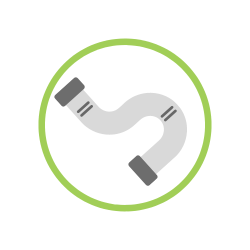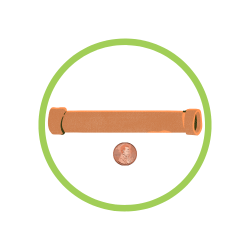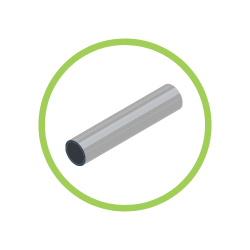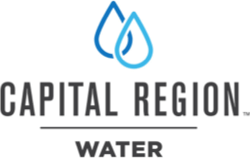What efforts does Capital Region Water take to protect my household from lead?
Since its inception in 2013, Capital Region Water has maintained a commitment to providing safe, clean drinking water throughout its service area, which includes about 60,000 people in the City of Harrisburg and its surrounding municipalities.
Enhancing that commitment, CRW has launched a new lead risk mitigation program that aligns with recently announced guidelines from state and federal regulators. Now, when CRW staff or contractors replace or disturb drinking water service lines in your area, customers will be notified if there is a related risk of lead exposure.
Lead is not present in the water CRW supplies for distribution, and CRW is unaware of any lead service lines in its system. CRW routinely tests its drinking water quality and continually meets or exceeds state and federal drinking water guidelines. Recent lead testing results have consistently been 0 parts per billion when water sampling is performed at the tap of residences throughout the service area. A part per billion is equivalent to one drop of water in a 10,000-gallon swimming pool.
However, lead may exist in customers’ and consumers’ homes, especially those with older plumbing. It’s likely that lead goosenecks — small, flexible pieces of pipe used to connect property owners’ water service lines to water mains — also exist throughout the system. Goosenecks were commonly made of lead from the 1920s and 1940s.
Lead can enter drinking water when old plumbing systems corrode. To proactively prevent corrosion, CRW adjusts the chemistry of its water, also adding a corrosion inhibitor (zinc orthophosphate). CRW is continually working to make water system improvements and lead goosenecks are removed and replaced with safer materials when they are discovered.
Out of an abundance of caution, CRW’s new risk mitigation measures will target properties where a project-related disturbance could cause increased exposure to lead. In those cases, CRW staff will notify property owners, inviting them to take advantage of the program, which will offer a filtered water pitcher (with a filter designed to last six months), as well as subsequent customer-performed, lead sample testing.
Eligible residents must opt into the program via signature after being notified by CRW.
How do I know if my home has a lead service line or lead plumbing?
You can hire a certified plumber to inspect both your service line and other materials in contact with your drinking water. Capital Region Water can also assist you by providing information and guidance on how to identify a lead service line or lead plumbing in your home.
You may be able to determine on your own if your service line is made of lead. Service lines typically enter the home in the basement or crawl space. If the pipe is lead, it will have a dull finish that shines brightly when scratched with a key or coin. Using a magnet can also help you identify a lead pipe, because even a strong magnet will not cling to a lead pipe.
Potential sources of lead in Drinking Water

Lead Goosenecks: Goosenecks and pigtails are shorter pipes that connect the lead service line to the main.

Copper Pipe with Lead Solder: Solder made or installed before 1986 contained high lead levels.

Faucets: Fixtures inside your home may contain lead. Especially if installed before 1986.

Galvanized Pipe: Lead particles can attach to the surface of galvanized pipes.

Lead Service Line: Lead service lines can be a major source of lead contamination in water.
How does this impact me and my health?
Exposure to lead in drinking water can cause serious health effects in all age groups. Infants and children can have decreases in IQ and attention span. Lead exposure can lead to new learning and behavior problems or exacerbate existing learning and behavior problems. The children of women who are exposed to lead before or during pregnancy can have an increased risk of these adverse health effects. Adults can have increased risks of heart disease, high blood pressure, kidney, or nervous system problems.
After a repair on my lead gooseneck, what should I do?
- Remove and clean all faucet aerators after the service line is returned to service but before using the water for consumption. Flush your service line and all internal plumbing by opening all taps (bathroom/bathtub faucets, sinks, showers), beginning with the lower level of your home and working your way to the upper level, and letting the cold water run for at least 30 minutes, and re-install the cleaned aerators.
- To conserve water instead of simply running the water for 30 minutes, other household/non-potable water usage activities such as washing clothes, showering, flushing the toilet, and running the dishwasher are effective methods of flushing the pipes.
- After the initial flush, run the water for 3-5 minutes before using and use cold water for cooking and drinking to reduce your exposure to lead in the water. It is recommended to routinely flush the lines for the next 30 days each morning or after an extended period of no water usage.
- In addition to flushing the lines, CRW is providing customers with a pitcher filter that is certified to remove lead and a filter cartridge with a 6-month (120-gallon) lifespan. This filter may be used for water that will be used for drinking and cooking.
Adding a faucet filter has been shown to be effective in the removal of or reduction of lead when they are installed and maintained properly. The filter model you select must be certified to reduce lead according to the National Sanitation Foundation industry standards for filtration products and systems.
What about other water contaminants?
Every year, Capital Region Water publishes a “Drinking Water Quality Report” that outlines the results of water quality testing for a number of contaminants.
Lead & Copper Rule FAQs
If present, elevated levels of lead can cause serious health problems, especially for pregnant women and young children. Lead in drinking water is primarily from materials and components associated with service lines and home plumbing. Capital Region Water is responsible for providing high-quality drinking water, but cannot control the variety of materials used in household plumbing components.
Under strict state and federal regulations, Capital Region Water is required to test for copper and lead in its drinking water every three years. Samples for this testing are taken directly from customer faucets in areas with the oldest buildings, which are more likely to contain lead in their indoor plumbing. Based on Capital Region Water’s service area size, a minimum of 30 samples are collected for each testing period every three years.
Customers can contract with a local environmental testing lab or purchase in-home test kits at their local hardware store. Capital Region Water does not recommend or endorse any specific laboratory or in-home test kit.
Capital Region Water will be collecting samples this year between June and September as part of our regulatory requirements. Results will be distributed to customers via newsletter and CRW website, as well as the 2023 Water Quality Report.
Following the mandated Lead and Copper Rule sampling plan, Capital Region Water recently completed its required Lead and Copper Rule sampling plan by testing 45 high-risk residential homes throughout its service area in 2022.
State and federal regulations require the 90th percentile lead level to be less than 15 parts per billion, meaning the lead level must not exceed this level in at least 90 percent of the homes sampled. Capital Region Water’s result was 0 parts per billion. Capital Region Water will test for lead and copper again in 2025.
Lead is not present in the water Capital Region Water sends into the distribution system. Lead can enter the water when there is corrosion of lead joints on water mains or plumbing systems containing lead. To prevent the corrosion of pipes, Capital Region Water adjusts the pH of the water and adds a corrosion inhibitor to prevent corrosion of water mains and indoor plumbing.
When your water has been sitting for several hours, such as overnight, you can minimize the potential for lead exposure by flushing your tap for 30 seconds to 2 minutes before using water for drinking or cooking. If you are concerned about lead in your water, you may wish to have your water tested. Information on lead in drinking water, testing methods, and steps you can take to minimize exposure is available from the Safe Drinking Water Hotline:
(800-426-4791) or at: http://www.epa.gov/safewater/lead
